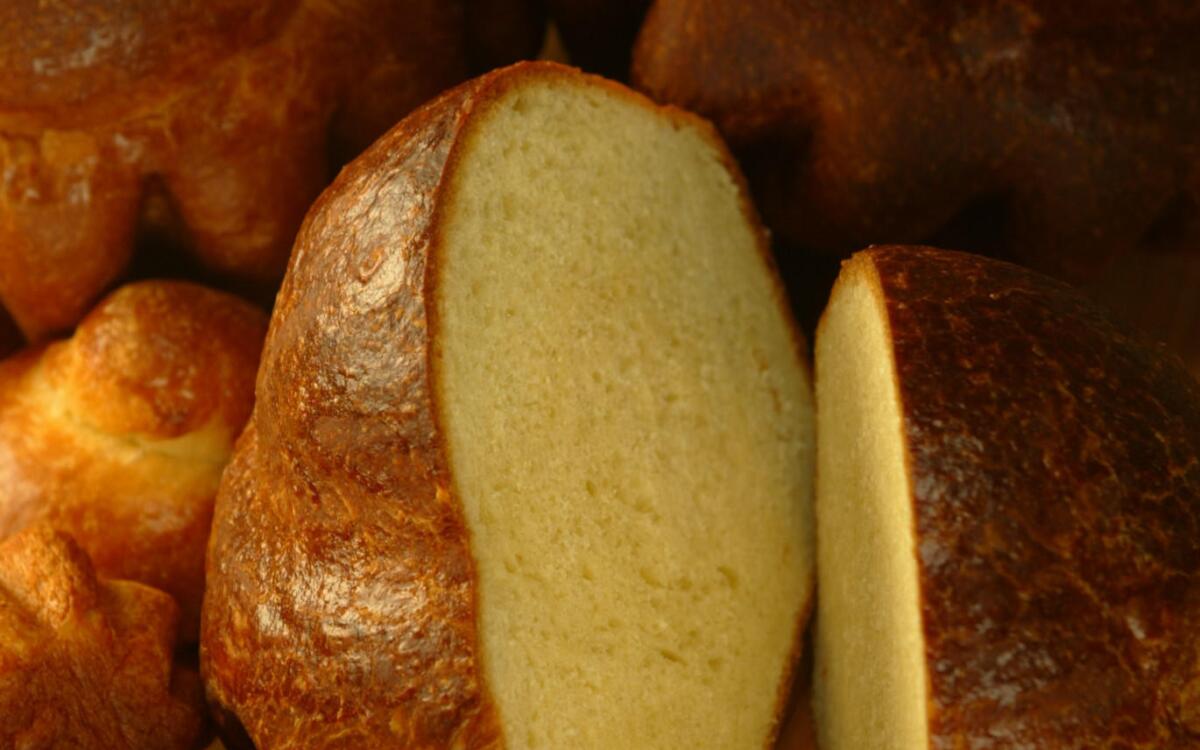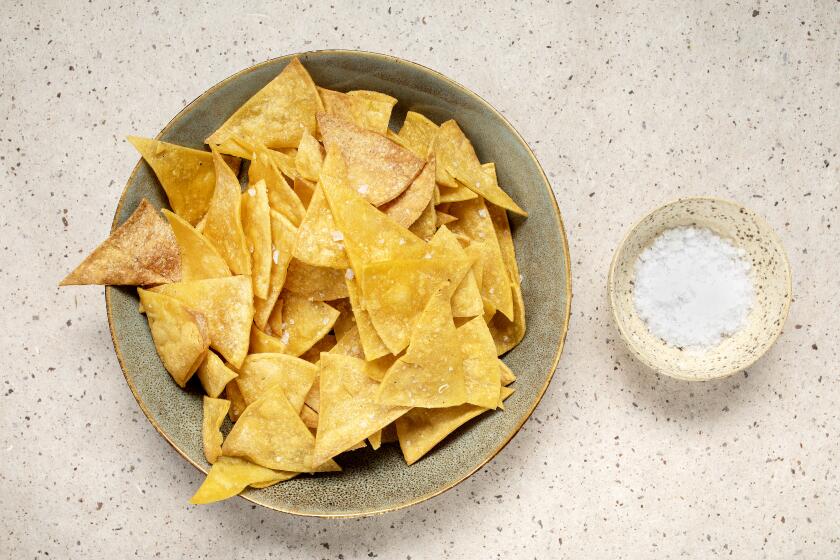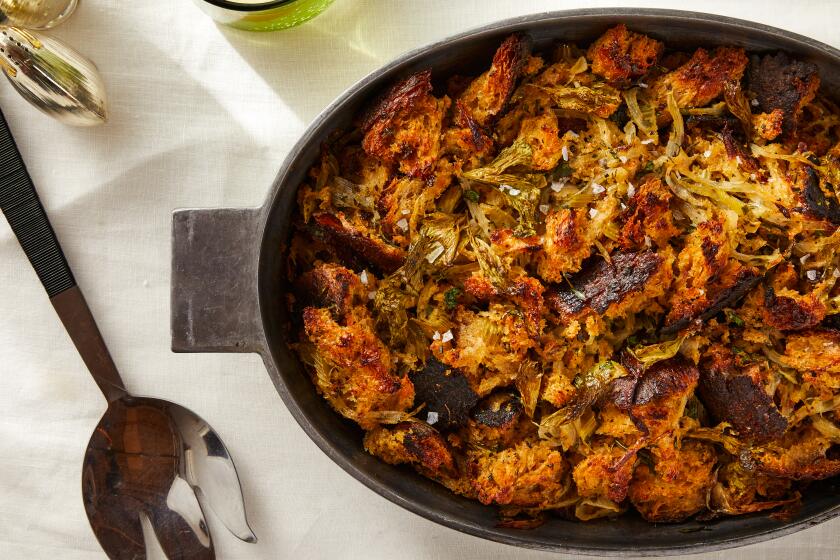Brioche

Brioche may be the perfect bread for spring. It’s light and airy -- and beautiful, with fat fluted edges and a jaunty knob atop a crust that’s shiny golden brown. A basket of mini-brioches is irresistible on a buffet table, or set out a large one on a cutting board at the dinner table. A great brioche has a hint of sweetness, and the rich flavor of eggs and butter.
In France, brioche is popular as a breakfast cake. In fact, Marie Antoinette’s famous “Let them eat cake” was actually “Qu’ils mangent de la brioche.” Brioche dough is used to enrobe sausages or pates before baking, while foie gras is often served with sliced and toasted brioche. By extension, toasted brioche is also wonderful with chicken liver mousse or softer pates; it makes excellent sandwiches, and it’s swell with Champagne. Or you can just serve it warm with homemade strawberry jam.
In the unlikely event there’s any left over, slice some up for French toast the next morning. There’s nothing better.
Making brioche can seem intimidating; it’s certainly easier to hop in the car and pick some up at the nearest decent bakery. Yet there’s something so wonderful about pulling it out of the oven, steaming hot, and tearing off a tender, feathery morsel. And the truth is, in the world of bread-baking, brioche is much less complicated and more forgiving than something like pain au levain.
The trick would be finding the best recipe: one that resulted in a brioche with the best flavor and texture with the least time and effort.
Some brioche recipes call for kneading, but I looked for recipes in which a stand mixer would do the work. I found them in “The New Doubleday Cookbook,” Julia Child’s “Baking With Julia,” (written by Dorie Greenspan) and Jacques Pepin’s “La Technique.”
Brioche can be made with or without a starter (an extra step for fermenting yeast, which adds depth of flavor). The yeast mixture or starter is beaten for a long time with flour, eggs, butter, sugar and salt. Recipes differ in how the ingredients are added. As the dough is beaten, it becomes very elastic.
The classic brioche a tete (topped brioche) isn’t the only way to go; you can also shape them into loaves or simple rolls. Brioche pans, small and large, are now easy to find in better cookware stores.
I started with the recipe from “The New Doubleday Cookbook,” called Brioche II (Easy Method), chosen because it looked so simple. It required no starter, just a packet of yeast.
Unlike Child’s recipe (developed with Nancy Silverton), which called for beating the dough before adding the butter bit by bit, the Doubleday recipe required creaming the butter until fluffy before adding the flour mixture and eggs. Though the resulting brioche had good color -- a nice golden brown -- the crust was a bit thick, almost dry.
Next I tried the Pepin recipe. I was almost certain this would be the best. Pepin, after all, is French, and a master of technique. This one required no starter; you just let the yeast mixture ferment for 5 minutes, then all the ingredients were beaten together -- for just 8 minutes, as compared with 15 for Child’s recipe. The most striking difference here was the amount of sugar called for, just 1/2 teaspoon. (The Doubleday recipe called for 3 tablespoons, and Child’s used 1/3 cup.)
But the Pepin brioche came out of the oven not very brown, with a crumb that was almost pudding-like. The flavor was overwhelmingly eggy and very buttery.
In the end, the Child-Silverton recipe was the favorite -- not just for me, but for the entire Times food staff. The crust was a gorgeous, deep golden brown -- helped perhaps by the extra sugar -- and the crumb was delicate, feathery and light. The flavor was deep and wonderful: just eggy enough, nice and buttery, with only a tiny hint of sweetness.
Their recipe takes a bit more work: You need to make a sponge starter, which is the quickest of starters to assemble but still tacks on an extra 30 to 40 minutes. The recipe also tested our stand mixer’s endurance (a sturdy stand mixer is recommended) since it called for beating the dough for such a long time. That extra seven minutes beyond Pepin’s recipe, though, may be what produced the extra fluffiness in the brioche. Beginning with a starter resulted in deeper flavor, so it was well worth it, especially because you can let the dough rise overnight.
But then I thought, why let the dough rise in a bowl overnight, as Child suggests, when it could just as easily rise in the pan? That way, there’d be no rolling and shaping the same morning you wanted to serve and bake the bread. It would be done the night before.
When I tried this, it worked beautifully. The next day I had fresh brioche cooling on a rack, still warm as I was about to serve it.
Sponge
Sprinkle the yeast over the warm milk in a mixing bowl. Stir until the yeast is completely dissolved.
Stir in the egg and 1 cup of the flour until blended. Sprinkle the remaining 1 cup of flour over the sponge to cover.
Set the sponge aside to rest 30 to 40 minutes. After resting, the flour will look crackly.
Dough
Add the sugar, salt, 4 beaten eggs and 1 cup of flour to the sponge. Using the dough hook on a stand mixer, mix on low speed for a minute or two, just until the ingredients look as if they’re about to come together. Still mixing, sprinkle in one-half cup flour. When the flour is incorporated, increase the mixer speed to medium and beat for about 15 minutes, stopping to scrape down the hook and bowl as needed. During this mixing period, the dough should come together, wrap itself around the hook, and slap the sides of the bowl. If, after 7 to 10 minutes, you don’t have a cohesive, slapping dough, add up to 3 tablespoons flour. Continue to beat, giving the dough a full 15 minutes in the mixer -- don’t skimp on time; this is what will give the brioche its distinctive texture.
In order to incorporate the butter into the dough, you must work the butter until it is the same consistency as the dough. Smash the butter with a rolling pin or work it with a dough scraper until it is soft and pliable. When it’s ready, the butter will be smooth and still cool, not warm, oily or greasy.
With the mixer on medium-low, add the butter a few tablespoons at a time. When all of the butter has been added, raise the mixer speed to medium-high for a minute, then reduce the speed to medium and beat the dough until you once again hear the dough slapping against the sides of the bowl, about 5 minutes. Clean the sides of the bowl frequently as you work. If it looks as though the dough is not coming together after 2 to 3 minutes, add up to 1 tablespoon more flour. When you are finished, the dough should still feel somewhat cool. It will be soft and still sticky and may cling slightly to the sides and bottom of the bowl.
For the first rising transfer the dough to a very large buttered bowl, cover tightly with plastic wrap, and let it rise at room temperature until doubled in bulk, about 2 hours.
For the second rising deflate the dough by punching it down in the bowl and folding it over. Transfer the dough to a lightly floured board and knead a few times. Divide the dough in half to make 2 (8-inch) brioche. (Keep the dough that you are not working with covered in the refrigerator.) Shape three-quarters of the dough from each half into a ball on a lightly floured surface and place into 2 (8-inch) buttered nonstick brioche pans. Roll each of the remaining balls of dough into a pear shape. Use your fingers to make an indentation in the center of one brioche and fit the narrow end of the ball into the depression. Repeat with the remaining dough.
Cover the dough lightly with buttered plastic wrap or an inverted bowl and refrigerate. Let rise until doubled in bulk, 4 to 6 hours or overnight. Remove from the refrigerator and let stand at room temperature. Let rise until doubled in bulk, about 1 hour.
Heat the oven to 375 degrees.
Brush the top of the brioche with beaten egg, taking care not to let the egg dribble onto the pan. Bake until golden brown, about 30 minutes. If the bread is browning too quickly, cover it lightly with foil. To test for doneness, insert a thermometer in the bottom of the bread. It should reach 200 degrees.
Let the brioche cool in the pans about 5 minutes, then remove the bread from the pans and let cool on a wire rack.
Get our Cooking newsletter.
Your roundup of inspiring recipes and kitchen tricks.
You may occasionally receive promotional content from the Los Angeles Times.















